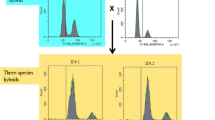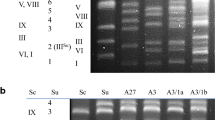Summary
Rare-mating of closely related Saccharomyces cerevisiae and S. diastaticus strains led to the formation of different hybrids. Mating-type switching and chromosome losses could be observed by means of classical genetic analysis and pulsed field gel electrophoresis of intact chromosomes. The latter was facilitated by extensive chromosome length polymorphism in both strains. When crossing the two haploid strains S. cerevisiae 41 α and S. diastaticus ATCC 28339 α, two different types of hybrids occurred. Both types showed complete addition of both parental genomes, one aα-status and the other αα-status. The αα-status could be explained by assuming a transient premutational lesion in MAT α. Usually lesions are repaired after a mating event and the α-mating type is restored. When crossing a diploid S. diastaticus strain, isogenic to the one previously mentioned, with the haploid S. cerevisiae strain, three different types of hybrids could be distinguished regarding their mating-types. It was possible to prove that the haploid S. diastaticus strain ATCC 28339 is disomic and the diploid hybrid, named 41ATCC-b, is trisomic for chromosome I. This could be shown by means of electrophoretic karyotyping of the hybrid and of the four single-spore cultures from one ascus of the hybrid.
Similar content being viewed by others
References
Bakalinsky AT, Snow R (1990) The chromosomal constitution of wine strains of Saccharomyces cerevisiae. Yeast 6:367–382
Carle GF, Olson MV (1985) An electrophoretic karyotype for yeast. Proc Natl Acad Sci USA 82:3756–3760
Cox BS, Bevan EA (1962) Aneuploidy in yeast. New Phytol 61:342–355
Emeis CC (1958) Die Gewinnung von Ascosporenmassen von Saccharomyces-Arten auf Grund besonderer Oberflächeneigenschaften. Naturwissenschaften 45:411
Emeis CC, Gutz H (1958) Eine einfache Technik zur Gewinnung von Hefesporen. Z Naturforsch Teil B 13:647–650
Klar A, Strathern J, Hicks JB (1984) Developmental pathways in yeast. In: Losick R, Shapiro L (eds) Microbial development. Cold Spring Harbor Laboratory. Cold Spring Harbor, N.Y., pp 151–195
Ono B, Ishino-Arao Y (1988) Inheritance of chromosome length polymorphisms in Saccharomyces cerevisiae. Curr Genet 14:413–418
Repnevskaya MV, Karpova TS, Inge-Vechtomov SG (1987) Hybridization and cytoduction among yeast cells of the same mating type. Curr Genet 13:511–517
Schwartz DC, Cantor CR (1984) Separation of yeast chromosome-sized DNA by pulsed field gradient gel electrophoresis. Cell 37:67–75
Southern EM (1975) Detection of specific sequences among DNA fragments separated by gel electrophoresis. J Mol Biol 98:503–517
Strathern J, Hicks J, Herskowitz I (1981) Control of cell type in yeast by the mating type locus. The α1-α2 hypothesis. J Mol Biol 147:357–372
Williamson DM, Fennell DJ (1976) The use of fluorescent DNA binding agent for detection and separating yeast mitochondrial DNA. Methods Cell Biol 12:335–351
Zimmermann M, Hoffmann-Hintz M, Kolvenbach M, Emeis CC (1988) OFAGE banding patterns of different yeast genera and of intergeneric hybrids. J Basic Microbiol 28:241–247
Author information
Authors and Affiliations
Rights and permissions
About this article
Cite this article
Schillberg, S., Zimmermann, M. & Emeis, CC. Analysis of hybrids obtained by rare-mating of Saccharomyces strains. Appl Microbiol Biotechnol 35, 242–246 (1991). https://doi.org/10.1007/BF00184695
Received:
Accepted:
Issue Date:
DOI: https://doi.org/10.1007/BF00184695




